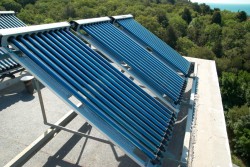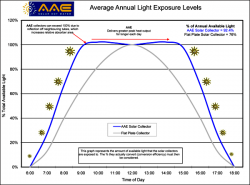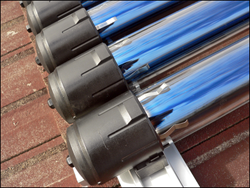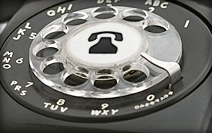Evacuated tube Solar Systems
A solar water heater uses energy from the sun to heat water for your home. Solar panels on your roof colle ct the sun’s rays and heat the water, which then flows to a storage tank, ready for use.
ct the sun’s rays and heat the water, which then flows to a storage tank, ready for use.
A solar water heater is an effective way to make use of Australia’s abundant sunshine. Depending on your location, the direction your solar panels face and the amount of water you use, a solar water heater can provide between 50 and 90 per cent of your hot water needs. Solar water heaters come with electric or gas boosters to provide the rest of your hot water needs.
If a solar water heater is right for you, it can save you energy, save you money and reduce your greenhouse gas emissions.
How does it work?
- Solar water heaters use a tank to store water that has been heated by the sun.
- Cold water flows from the tank to the solar collector, usually positioned on your roof. In a split system like the one shown here, cold water is pumped up to the collector. In a thermosyphon system with the tank above the collectors on the roof, cold water flows naturally into the collector because it is heavier than hot water.
- The solar collector is made of materials that absorb the sun’s heat very efficiently. The cold water travels through the collector and the heat in the collector heats up the water, which returns to the tank.
- Hot water floats to the top of the tank and colder water is taken from the bottom and returned to the solar collector. When you need hot water, it is taken from the top of the tank where the water is hottest.
Types of solar water heaters
There are many different solar hot water heaters available. It is important to select the hot water system that is most suited to your family size, climate, house type, roof characteristics, water quality, available space and aesthetic preferences. You will have choice in the selection of solar collector technology, boosting system, tank type and tank positioning.
Solar collector options
The two main types of solar collectors are flat plate panels and evacuated tube systems. Flat plate panels have been used for around 40 years and are commonly installed in Australia. They operate at maximum efficiency when the sun is directly overhead at midday but are less efficient at other times of the day when the sun’s rays hit the panels at different angles.
Evacuated tube collectors use an array of glass tubes that insulate in a similar way to a thermos flask where the heat energy is retained in the tube. Evacuated tubes can be more efficient than flat plate panels in some conditions, such as cold climates. The technology was invented in Australia in the late 1980s and the collectors have been fully commercialised in the last decade.
Flat plate panels:
- May require a special anti-freeze fluid for very low temperatures
- Are generally less expensive than evacuated tube systems
- Require cleaning to remove any dust, salt spray or sludge

Evacuated tube systems:
- Make more efficient use of the sun’s energy
- Are lightweight and can be easily installed on the roof
- Are low maintenance and cleaned by falling rainwater
- Can withstand very low temperatures without the need for an anti-freeze fluid
- Are generally more expensive than flat plate panels
- Individual tubes can be replaced if damaged.


Storage tank options
Storage tanks are made of different materials such as vitreous enamel (also called mild steel), stainless steel or copper. Your choice of tank material will be dependent on your water quality and whether you are connected to mains water supply or on tank water.
Vitreous enamel or mild steel tanks:
- Require a sacrificial anode that needs replacing to avoid corrosion, particularly in areas with hard water
- Have a glass-like coating inside which protects the steel from corrosion
- May corrode from the outside.
Stainless steel tanks:
- Are less prone to corrosion
- Do not require a sacrificial anode
- Are low maintenance
- Are not recommended in areas with poor water quality
Copper tanks:
- Are very long lasting and resistant to corrosion
- Are typically used in homes where water is supplied from a gravity feed system in the roof rather than mains water.
Gas or electric boosting
A solar water heater can meet most of your household’s hot water needs. However on days where hot water usage is higher than usual, or on cloudy or rainy days, water stored in your tank may need an additional boost to maintain your preferred water temperature.
The booster heating unit will only activate when the water temperature is below the thermostat setting and will automatically turn off when the temperature of the water reaches the thermostat setting. For further control, a manual on/off booster switch can be installed in a convenient location, such as in the kitchen or laundry. Boosters use an alternative source of energy, such as electricity or gas, to heat the water.
Consider the option of a manual on/off booster switch so that you can control the level of boosting to your system. This provides the option of switching off the booster in summer or when you are away.
Timers can also be used to ensure that the booster is used as little as possible and the maximum solar contribution is achieved.
Gas-boosting
A gas-boosted solar water heater generates the least greenhouse gas emissions of any low emission water heater. A gas-booster can be installed inside your hot water tank or between the hot water tank and your home. The second option delivers the lowest greenhouse gas emissions, as water is only heated to the desired temperature at the time of use, which reduces heat losses. A gas-booster between the tank and your home also ensures you will never run out of hot water, so is a great option for large families. Of course, gas-boosted solar hot water heaters can only be used in areas with a gas supply (including LPG).
Electric-boosting
Electric-boosted solar water heaters use an electric element located in the bottom of the tank, much like a kettle. Electric-boosted heaters generate more greenhouse gas emissions than gas-boosted heaters, unless the electricity used is from a low intensity source (i.e. from a renewable source).
Is it right for you?
Solar water heaters are quiet, use renewable energy from the sun and reduce your energy bill. Whether a solar water heater is the best available choice for you depends on your particular circumstances.
Do you have access to gas?
Whether or not you have access to gas, solar is an energy efficient option for water heating. The most greenhouse friendly option for water heating is a gas boosted solar hot water system. If you do not have access to gas, electric-boosted solar is also an option.
What climate do you live in?
Solar water heaters are suitable for all climates, including colder climates prone to frost and snow. Evacuated tube systems can be used in areas prone to frost and areas where temperatures reach below zero. Some flat plate systems work with a special anti-freeze fluid which guards collectors against freezing or cracking. In some cases, solar water heaters may be more suitable than heat pumps, which work less efficiently at low temperatures.
Where to place your solar collectors?
It is important that solar collectors receive full sunshine during the middle of the day when the sun is high in the sky and at its strongest. A solar hot water system will be suitable as long as your collectors won’t be shaded by trees or by an adjoining property.
Ideally you will have an area for your collectors that is facing north. If you have an east, west or south facing roof or area you will need to install a frame to angle the collector toward north for maximum exposure to the sun as it moves from east to west. Systems can still provide acceptable performance when not facing north, however performance diminishes as the panels face further south.
It is advisable to check your local council regulations for any restrictions or special requirements for the installation of solar water heaters.
How much hot water do you need and what sized system will you require?
No matter what size your household is or level of water use, a solar water heater can be matched to your requirements by selecting an appropriate tank capacity and number of collectors. See below for the size that is best for you.
Behavioural changes such as showering in the morning instead of at night will help in avoiding the use of the system booster, therefore lowering your hot water costs. Fitting low flow fittings to showers and taps will also minimise the amount of hot water you use.
Cost of installation
As well as considering the purchase cost of your solar hot water system, you will also want to consider the installation cost of the appliance. If your roof requires reinforcement to support the solar panels, it may significantly increase the cost of installation.
It is a good idea to also consider the warranties on the system components. Look for systems with a longer warranty.
Have your system installed by a registered installer, maintain it as required and have it serviced according to the manufacturer’s instructions.
If you are installing an electric boosted system ask your installer which electricity tariff you will be connected to, especially if you are currently on an off-peak tariff.
Where can you locate your hot water tank?
You have the option of locating your tank either on your roof, on the ground or in a roof cavity.
Roof mounted tanks are placed horizontally above your collectors. This type of arrangement is called a thermosiphon system. It does not require pumps or controllers and leaves your ground level space free. As roof mounted tanks can be quite heavy (300 to 700 kg) you will need to make sure your roof is strong enough to support this added weight. Roof reinforcing may only be needed for older buildings, and is not usually an issue for new housing. If in doubt contact a structural engineer for an assessment.
Placing your tank at ground level or in your roof cavity, called a split system, will require a pump for circulating the water to your collectors. The pump will need electricity to power it and will require maintenance. For this type of arrangement, it is best to locate your tank close to where hot water is used the most, such as near your bathroom or kitchen, to maximise efficiency.
You can also place your tank in a space inside your house such as in a spare cupboard. However, for inside tank installations, you will need to ensure that there is adequate drainage and an overflow pipe is fitted to avoid flooding. A new Australian standard has been introduced to address the overflow problem for new systems.
What size is best for you?
A solar hot water system can be tailored to your family size by selecting an appropriate tank capacity and number of collectors. The table below gives an indication of the tank capacity and number of collectors for different household sizes. Households that need a lot of hot water, such as those with spas or dishwashers, should select the next largest system size in the range. A dishwasher with a hot water connection should be counted as an extra person.
|
Number of householders |
Capacity (litres) |
Collector area (m2) |
|
1-2 |
160-200 |
2 |
|
3-4 |
300-370 |
4 |
|
5-6 |
440 |
6 |
Applications
The solar water heaters described here are appropriate for residential water heating in the home. Not all solar hot water heaters are suitable for pool heating. There are specially designed solar water heaters available for use with swimming pools.
Getting the most out of your solar hot water
A number of factors will affect the length of service your water heater will provide. These include water quality, water pressure, temperature and water usage patterns. However there are a range of things you can do to make sure you are getting the most out of your hot water system and to ensure it runs its full length of service, which is usually about 10-12 years.
Maintenance
Be sure to follow the manufacturer’s recommendations for maintenance. If you have a vitreous enamel tank you will need to replace the sacrificial anode every five years. This anode collects any rust that may form in your tank.
Insulation
If your tank is located outside you can minimise heat loss by fitting insulating jackets around the tank. Insulating the pipes will reduce heat losses and provides corrosion protection. Insulation should be at least 10mm thick, especially if pipes are exposed to the outside environment. It is important that insulation is installed at the time your hot water system is being installed.
Cleaning your collectors
Ensure the glass on your solar collectors is free of dust, salt spray or any other matter, which may reduce the effectiveness of the solar collectors. Hose or wash the collector glass with water and a soft brush when the solar collectors are cool. Trim any trees which may shade the solar collectors.
Going on holidays
Remember to turn the booster switch off when you are going away, to conserve energy.
How you can maximize performance?
By angling your collectors to between 40 and 50 degrees you can achieve better winter performance because the sun is lower in the sky in winter. This also helps minimise loss of water through the pressure and temperature valve. The purpose of this valve is to release steam that may build up in your system. This prevents overheating, especially in the summer months when the sun is stronger.
If you have a flat roof you will enhance the performance of your system by installing a frame that will allow you to angle the collectors to at least 22 degrees but preferably between 40 and 50 degrees.
Health and safety
The thermostat on your booster should be set to at least 60°C to kill any pathogens and avoid the growth of legionella bacteria.
The maximum safe temperature for tap water in order to avoid burns is 50°C. A temperature valve will ensure that water is delivered at a safe temperature.
Installation
It is important that your system is installed by an accredited plumber. See below for information about how to find an accredited plumber.
Retrofitting an existing system?
If you have a tank that is less than five years old then you can consider retrofitting your system as it may be cheaper for you not to have to purchase a new tank. You can couple new solar collectors with your existing tank but you will need to install a five way valve in your tank. Ask your supplier or plumber for more information.
You are unable to claim government rebates or Renewable Energy Certificates for retrofitted systems.


